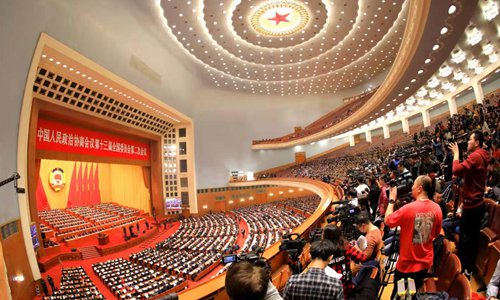Proactive fiscal policies expected at two sessions: Chinese experts
Source:Global Times Published: 2020/5/14 23:34:27

The 13th Chinese People's Political Consultative Conference (CPPCC) National Committee kicks off its annual meeting on Sunday at the Great Hall of the People in Beijing, marking the start of this year's two sessions - the annual meetings of the CPPCC and the National People's Congress, China's top legislature - the most important annual political event in China. Photo: VCG h. Photo: AFP
Proactive fiscal policies are expected at the upcoming two sessions, a major event in China's political calendar, and are needed to promote the recovery of the real economy from the fallout of the deadly coronavirus pandemic.
Currently, Chinese fiscal policies should be strengthened, with measures such as raising the fiscal deficit rate to 5 percent of GDP and issuing 3 trillion yuan ($423 billion) in special treasury bonds to expand the sources of fiscal funding.
The continually strong financial data in China amid the pandemic showed that the loose tone of China's monetary and credit policy has been set. According to data from China's central bank, both newly increased social financing and loans saw new highs in the first four months, which showed the recovery of demand for financing as production in China has resumed.
Official data showed that newly increased loans in April reached 1.7 trillion yuan, up 680 billion yuan year-on-year.
Per data from the Ministry of Industry and Information Technology, nearly 90 percent of China's medium and small-sized firms had resumed operation by late April. As well as financing demand recovering, the proportion of medium and long-term loans have increased. Support for the real economy from the financial sector under the guidance of policies has been enhanced and might pave the way for further investment recovery.
Also, the newly increased social financing in April totaled 3.09 trillion yuan, up 1.42 trillion yuan year-on-year.
Growth in broad M2 money supply edged up to 11.1 percent year-on-year in April, the highest rate since December 2016.
In general, a loose tone of China's monetary and credit policy has been in place. On the basis of overall easing, the flexible use of monetary policy tools to lower financing costs for the real economy and increasing medium and long-term loan supply to enterprises, especially small and medium-sized firms, are still the core tasks.
With the epidemic largely under control in China, the impact on the supply side has been eased, and the biggest challenge for China's economic growth currently is insufficient effective demand due to the lag in domestic consumption recovery and reduced overseas orders.
Besides the loose monetary policy, a proactive fiscal policy is needed and the upcoming fiscal policy discussions at the two sessions will be critical for boosting the recovery of the real economy.
The article was compiled based on analysis written by Shen Jianguang and Zhang Xiaochen. Shen is a deputy president of JD.com Inc and chief economist of JD Digits. Zhang is a research fellow in the research institute of JD Digits. bizopinion@globaltimes.com.cn
Posted in: EXPERT ASSESSMENT